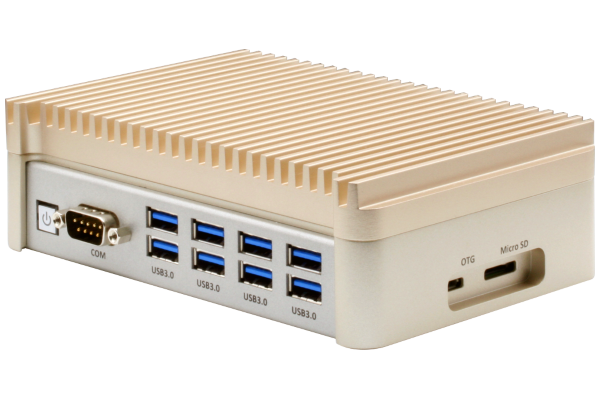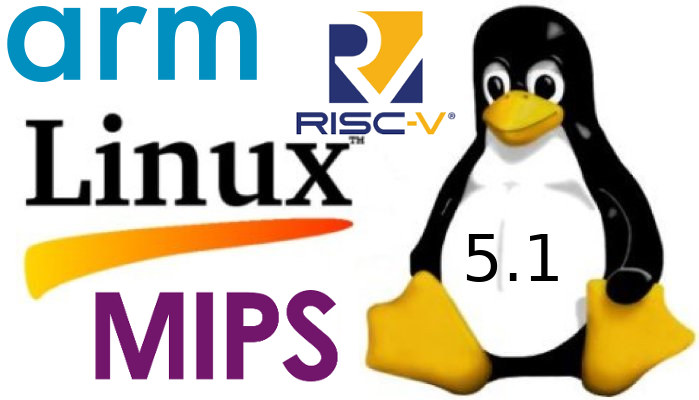The new compact embedded solutions’ addition to the BOXER-8100AI family is specially designed for artificial intelligence (AI) support. According to its makers, AAEON, it has a configuration of eight USB 3.0 ports made available through four USB controllers chips. This makes it perfect for a wide range of computer vision applications, some of which are visual inspection, quality control, and facial recognition. Now, each USB chip controls a pair of USB 3.0 ports. By dedicating one chip to one pair of ports, each chip handles less data traffic overall. This also improves bandwidth from connected devices and allows the BOXER-8150AI to maximize speeds and framerates of AI image processing. The product is currently in stock and available for purchase on AAEON online store for $1,142.00. Key Features of BOXER-8150AI Nvidia TX2 Module HMP Dual Denver 2 + Quad ARM A57 8GB LPDDR4 32GB eMMC 5.1 HDMI 2.0 8x USB […]
Linux 5.1 Release – Main Changes, Arm, MIPS & RISC-V Architectures
Linus Torvalds has just announced the release of Linux 5.1: So it’s a bit later in the day than I usually do this, just because I was waffling about the release. Partly because I got some small pull requests today, but mostly just because I wasn’t looking forward to the timing of this upcoming 5.2 merge window. But the last-minute pull requests really weren’t big enough to justify delaying things over, and hopefully the merge window timing won’t be all that painful either. I just happen to have the college graduation of my oldest happen right smack dab in the middle of the upcoming merge window, so I might be effectively offline for a few days there. If worst comes to worst, I’ll extend it to make it all work, but I don’t think it will be needed. Anyway, on to 5.1 itself. The past week has been pretty calm, […]
ZED Depth and Motion Tracking Camera Supports NVIDIA Jetson Nano Board
When NVIDIA launched their low cost Jetson Nano development board earlier this week, one reader asked whether it would support binocular depth mapping. It turns out Stereo Labs has updated the SDK (Software Development Kit) for the ZED depth and motion tracking camera in order to support the latest NVIDIA developer kit. Jetson Nano can manage depth and positional tracking at 30 fps in PERFORMANCE mode with 720p resolution, and while the more powerful and expensive Jetson TX2 achieves doubles the performance at 60 fps, it does so at a much higher cost. ZED depth and motion tracking camera specifications: Video 2.2K @ 15 fps (4416×1242 resolution) 1080p @ 30 fps (3840×1080 resolution) 720p @ 60 fps (2560×720 resolution) WVGA @ 100 fps (1344×376 resolution) Depth Resolution – Same as selected video resolution Range – 0.5 to 20 m Format – 32-bits Stereo Baseline – 120 mm Motion 6-axis Pose […]
NVIDIA Introduces $99 Jetson Nano Developer Kit
NVIDIA Tegra X1 octa-core Arm processor with a 256-core Maxwell GPU was introduced in 2015. The processor powers the popular NVIDIA Shield Android TV box, and is found in Jetson TX1 development board which still costs $500 and is approaching end-of-life. The company has now introduced a much cheaper board with Jetson Nano Developer Kit offered for just $99. It’s not exactly powered by Tegra X1 however, but instead what appears to be a cost-down version of the processor with four Arm Cortex-A57 cores clocked at 1.43 GHz and a 128-core Maxwell GPU. Jetson Nano developer kit specifications: Jetson Nano CPU Module 128-core Maxwell GPU Quad-core Arm A57 processor @ 1.43 GHz System Memory – 4GB 64-bit LPDDR4 @ 25.6 GB/s Storage – microSD card slot (devkit) or 16GB eMMC flash (production) Video Encode – 4K @ 30 | 4x 1080p @ 30 | 9x 720p @ 30 (H.264/H.265) Video […]
BOXER-8120AI is a Compact Jetson TX2 Mini PC for Drones, Robots and Surveillance Applications
AAEON has just launched BOXER-8120AI compact mini PC based on NVIDIA Jetson TX2 processor module with 8GB RAM, 32GB storage, and four Gigabit Ethernet ports. The fanless mini PC targets smart surveillance/ security/ parking, unmanned stores, drones and robotic controllers, or any applications that can leverage Jetson TX2’s 256 CUDA cores for A.I. workloads. BOXER-8120AI Jetson TX2 Mini PC specifications: Processor Module – NVIDIA Jetson TX2 with HMP Dual Denver 2 + Quad Arm A57, NVIDIA Pascal GPU with 256 CUDA cores, 4K (HEVC) video encoder, 4K 12-bit video decoder System Memory – 8GB LPDDR4 @ 59.7 GB/s Storage – 32GB eMMC 5.1 flash, MicroSD slot Display Interface – HDMI 2.0 type A Networking – 4x 10/100/1000Base-TX Ethernet USB – 2x USB 3.0 ports, 1x micro USB OTG port Serial – 2x COM ports (DB9) Misc – Power Button, Power LED, 2x SMA Holes, Remote Power On/Off Power Supply – […]
Autoware is an “All-in-One” Open-source Software for Autonomous Driving
All major automotive companies, and some technology companies are all working on autonomous driving with the ultimate goal of achieving level 5 autonomous driving meaning no human intervention is needed at any stage. Development will take some more time, and companies are now competing with closed source software and hardware. But as I browsed through Linaro Connect Bangkok 2019 schedule, I found out there’s an open source autonomous driving software called Autoware.AI. Several “Autoware” projects are managed by the newly founded Autoware Foundation, a non-profit organization created to develop a synergy between corporate development and academic research in order to provide access to autonomous driving technology for everyone: Autoware.AI is the first version built on ROS 1, and Linux, and has been developed as a research and development platform Autoware.auto is the second version built on ROS 2, and Linux, with a complete redesign. Autoware.IO is an interface project for Autoware […]
NVIDIA Jetson TX2i Module is Designed for Industrial Environments
NVIDIA Jetson TX2 “Artificial Intelligence Computer” module was announced in March 2017 with a Tegra X2 hexa-core processor, a 256-core Pascal GPU, 8GB RAM, 32GB storage, and support for 4K 60 fps encoding and decoding. But it turns out NVIDIA announced an rugged version of the module dubbed Jetson TX2i designed for reliable operation in harsh industrial environments in March of this year. NVIDIA Jetson TX2 and TX2i are pin-to-pin compatible, and can run the same software, but TX2i has been designed and tested for rougher conditions. Feature Jetson TX2 Jetson TX2i Shock 140G, 2ms 140G, 2ms Vibration 10Hz ~200Hz, 1g & 2g RMS Random: 5g RMS 10 to 500Hz Sinusoidal: 5g RMS 10 to 500Hz Temp Range -25°C – 80°C -40°C – 85°C Humidity 85°C / 85% RH, 168 hours -10°C to 65°C / 95% RH, 240 hours Operating Life 5 Years (GB at 35C: MTBF=1,747,520 hours GF at […]
Axiomtek eBOX560-900-FL Ubuntu 16.04 Fanless Embedded Computer is Powered by NVIDIA Jetson TX2 Module
Axiomtek has unveiled eBOX560-900-FL fanless embedded computer equipped with an NVIDIA Jetson TX2 module, two Gigabit Ethernet ports, a HDMI 2.0a port, an NVMe slot, etc. It also supports WiFi and LTE connectivity for gateway applications. The rugged computer runs Ubuntu 16.04, targets high performance AI workloads such as machine vision, deep learning, and edge computing, and comes with IP40 protection, vibration resistance, and -10 to 50°C temperature range support. Axiomtek eBOX560-900-FL specifications: SoM – NVIDIA Jetson TX2 module with SoC – NVIDIA TX2 hexa-core processor with 2x Denver cores, 4x Arm A57 cores, and a 256-CUDA core NVIDIA Pascal GPU System Memory – 8GB 128-bit LPDDR4 @ 1866 MHz Storage – 32GB eMMC flash Storage – 1x M.2 2280 M-Key slot w/ PCIe 2.0 x4 (supports M.2 NVMe SSD) Video Output – 1x HDMI 2.0 with 4K2K support Connectivity 2x 10/100/1000 Mbps Ethernet (NVIDIA + Intel I210-IT) 802.11ac WiFI […]










